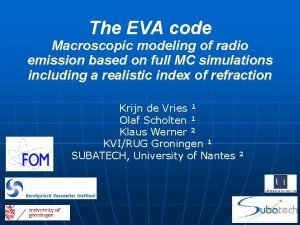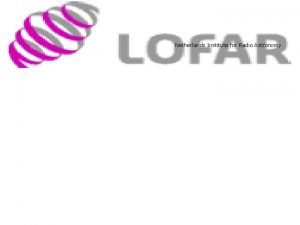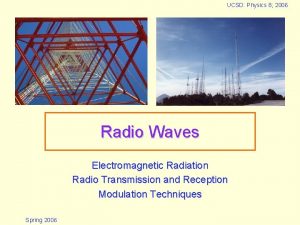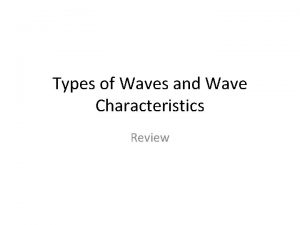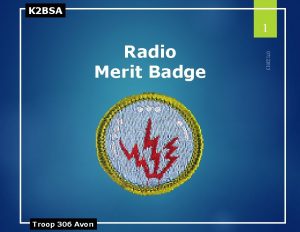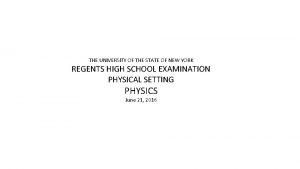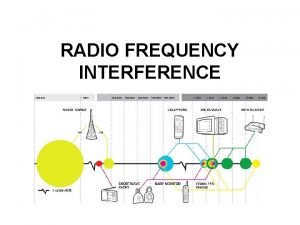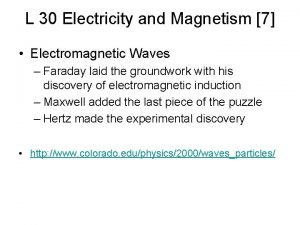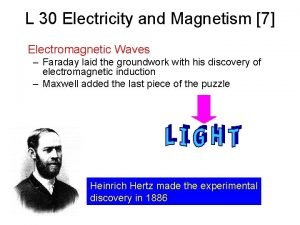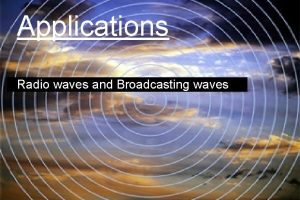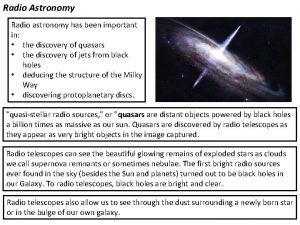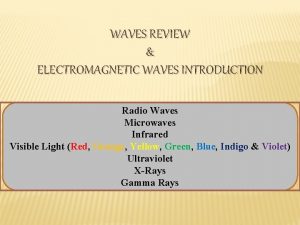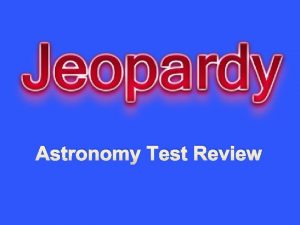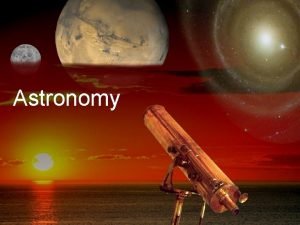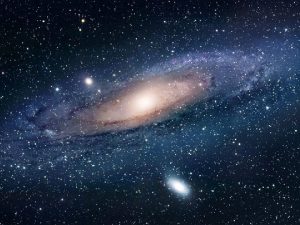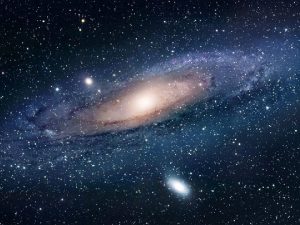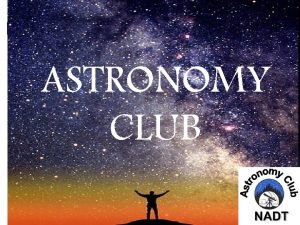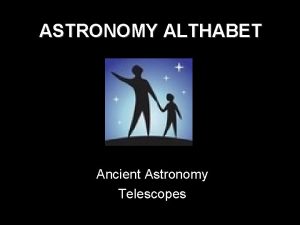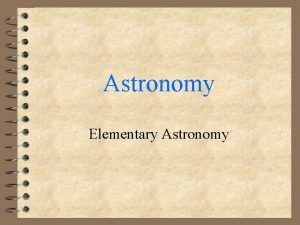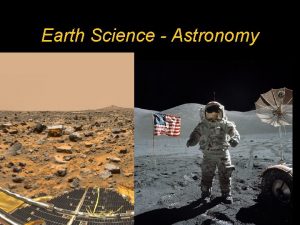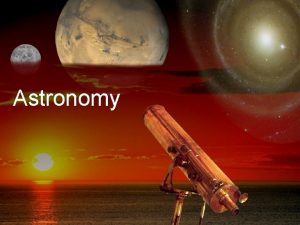Radio Astronomy Emission Mechanisms Recipe for Radio Waves






































- Slides: 38

Radio Astronomy Emission Mechanisms


Recipe for Radio Waves Thermal Continuum Radiation (Black Body Radiation) NRAO/AUI/NSF 4

NRAO/AUI/NSF 5

NRAO/AUI/NSF 6

Thermal or Black Body Emission NRAO/AUI/NSF 7

Thermal Continuum Radiation • Characteristics: – Opaque “Black” Body – Isothermal – In Equilibrium • Planck’s Law: – I = Intrinsic Intensity (ergs/cm 2/sec/Hz). – h = Planck’s Constant – k = Boltzman’s Constant – T in K – ν in Hz • Radio Approximation:

Recipe for Radio Waves Non-Thermal Continuum Radiation Whenever a charge particle is accelerated 1. Free-Free Emission • Hot (5000 K) Ionized Gases • • Planetary Nebulae HII Regions NRAO/AUI/NSF 9

Electron accelerates as it passes near a proton. Electromagnetic waves are released NRAO/AUI/NSF 10

Planetary Nebula and HII Regions

Free free emission NRAO/AUI/NSF 12

Recipe for Radio Waves Non-Thermal Continuum Radiation Whenever a charge particle is accelerated 1. Free-Free Emission 2. Synchrotron Radiation • Strong magnetic field • Ionized gases moving at relativistic velocities NRAO/AUI/NSF 13

Electrons accelerate around magnetic field lines Electromagnetic waves are released NRAO/AUI/NSF 14

NRAO/AUI/NSF 15

NRAO/AUI/NSF 17

NRAO/AUI/NSF 18

NRAO/AUI/NSF 20

Recipe for Radio Waves Spectral Line Radiation Atomic and molecular transitions NRAO/AUI/NSF 21

Gas Spectra Neon Sodium Hydrogen NRAO/AUI/NSF 22

Spectral-Line Radiation Recombination Lines • Ionized regions (HII regions and planetary nebulae) • Free electrons temporarily recaptured by a proton • Atomic transitions between outer orbital (e. g. , N=177 to M = 176) 2/26/2021 23

Hyperfine Transition of Hydrogen • Found in regions where H is atomic (HI). • Spin-flip transition – Electron & protons have “spin” – In a H atoms, spins of proton and electron may be aligned or anti-aligned. – Aligned state has more energy. – Difference in Energy = h * frequency • Frequency = 1420. 4058 MHz – An aligned H atom will take 11 million years to flip – But, 1067 atoms in Milky Way • 1052 H atoms per second emit at 1420 MHz. NRAO/AUI/NSF 24

NRAO/AUI/NSF 25

NRAO/AUI/NSF 26

Doppler Shift NRAO/AUI/NSF 27

Doppler Shift • c = speed of light = 3 x 105 km/sec • Rest Frequency = 1420. 4058 MHz for the hyperfine transition of Hydrogen • If V > 0, object is moving away from us • If V < 0, object is moving toward us. NRAO/AUI/NSF 28


Spectral-Line Radiation Milky Way Rotation and Mass? • For any cloud – Observed velocity = difference between projected Sun’s motion and projected cloud motion. • For cloud B – The highest observed velocity along the line of site – VRotation = Vobserved + Vsun*sin(L) – R = RSun * sin(L) • Repeat for a different angle L and cloud B – Determine VRotation(R) – From Newton’s law, derive M(R) from V(R)

Missing Mass 2/26/2021 32

Interstellar Molecules • About 90% of the over 140 interstellar molecules discovered with radio telescopes. • Rotational (electric dipole) Transitions • Up to thirteen atoms • Many carbon-based (organic) • Many cannot exist in normal laboratories (e. g. , OH) • H 2 most common molecule: – No dipole moment so no radio transition. – Only observable in UV (rotational) or Infrared (vibrational) transitions. – Astronomers use CO as a tracer for H 2 • A few molecules (OH, H 2 O, …) maser 2/26/2021 33



Molecules Discovered by the GBT 2/26/2021 36

Discovery of Ethanol

Interstellar Molecule Formation • Need high densities (100 – 106 H atoms/cm 3) – Lots of dust needed to protect molecules for stellar UV • Form in dust clouds = Molecular Clouds • Associated with stars formation – But, optically obscured – need radio telescopes • Low temperatures (< 100 K) • Some molecules (e. g. , H 2) form on dust grains • Most form via ion-molecular gas-phase reactions – Exothermic – Charge transfer 2/26/2021 38

Grain Chemistry

Ion-molecular gas-phase reactions Examples of types of reactions C+ + H 2 → CH 2+ + hν (Radiative Association) H 2+ + H 2 → H 3+ + H (Dissociative Charge Transfer) H 3+ + CO → HCO+ + H 2 (Proton Transfer) H 3+ + Mg → Mg+ + H 2 + H (Charge Transfer) He+ + CO → He + C+ + O (Dissociative Charge Transfer) HCO+ + e → CO + H (Dissociative) C+ + e → C + hν (Radiative) Fe+ + grain → Fe + hν (Grain) 2/26/2021 41

Organic Molecules; Seeds of Life NRAO/AUI/NSF 43

 Learning astronomy by doing astronomy
Learning astronomy by doing astronomy Learning astronomy by doing astronomy activity 1 answers
Learning astronomy by doing astronomy activity 1 answers Learning astronomy by doing astronomy activity 7 answers
Learning astronomy by doing astronomy activity 7 answers Is code 800
Is code 800 Netherlands institute for radio astronomy
Netherlands institute for radio astronomy Radio astronomy lectures
Radio astronomy lectures Seismic waves are mechanical waves
Seismic waves are mechanical waves How are rainbows made
How are rainbows made Difference between matter waves and electromagnetic waves
Difference between matter waves and electromagnetic waves Similarities of mechanical and electromagnetic waves
Similarities of mechanical and electromagnetic waves Compare and contrast p waves and s waves using venn diagram
Compare and contrast p waves and s waves using venn diagram What type of waves are sound waves? *
What type of waves are sound waves? * Mechanical and electromagnetic waves similarities
Mechanical and electromagnetic waves similarities Mechanical vs electromagnetic
Mechanical vs electromagnetic Light and sound travel in waves true or false
Light and sound travel in waves true or false Mechanical waves vs electromagnetic waves venn diagram
Mechanical waves vs electromagnetic waves venn diagram Sound is a longitudinal wave
Sound is a longitudinal wave Surface waves and body waves
Surface waves and body waves Mechanical waves examples
Mechanical waves examples Difference between constructive and destructive waves
Difference between constructive and destructive waves Long waves and short waves
Long waves and short waves Generation of radio waves
Generation of radio waves Sound waves from a radio generally travel in which medium?
Sound waves from a radio generally travel in which medium? Troop 306 avon
Troop 306 avon Electromagnetic chart
Electromagnetic chart A 65 kg astronaut weighs 638
A 65 kg astronaut weighs 638 Interference of radio waves
Interference of radio waves Electromagnetic spectrum lyrics
Electromagnetic spectrum lyrics James clerk maxwell
James clerk maxwell James clerk maxwell
James clerk maxwell Trunking vs conventional radio system
Trunking vs conventional radio system Gumman cirkel sång
Gumman cirkel sång Claes martinsson
Claes martinsson Rap texter som rimmar
Rap texter som rimmar Offentlig förvaltning
Offentlig förvaltning Klädsel i rom
Klädsel i rom Tidbok för yrkesförare
Tidbok för yrkesförare Fspos
Fspos Orubbliga rättigheter
Orubbliga rättigheter



